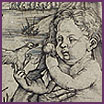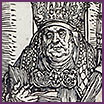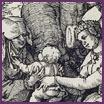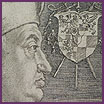|
|

|
||||

|

|

|

|

|
|
ALBRECHT DÜRER - MASTER ENGRAVER | |||||
|
Gösta Serlachius acquired several prints of Albrecht Dürer's works for his collection. All of the six Dürer pieces in the art museum have belonged to the Foundation since the early 1940s. The Foundation presents them on these pages because they can not always be on exhibit in the museum. They include two copperplate engravings and three woodcuts, because the Foundation's collection contains two prints of one of them. Before he became world-famous as a master engraver, Albrecht Dürer (1471-1528) had received an all-round artistic training. Among the skills that he had learned were those of a goldsmith, sketch artist and engraver, in addition to which he had studied decorative and artistic painting. He became widely famous in Europe at an early age. Dürer's woodcarvings and copper engravings were highly esteemed already in his own lifetime and very large numbers of prints of them were made. Dürer's woodcarvings were revolutionary, because they were large in size and contained very thin and dense lines closely resembling those in metal engraving plates. This demanded skill on the part of the woodcarvers who transposed Dürer's masterfully executed drawings onto wooden printing plates. By contrast, the master always engraved copper plates himself. Dürer's graphics combine in an incredible way the artist's creative imagination with the painstaking technical precision of a virtuoso. Dürer also studied perspective and the dimensions of the human body. He was the first Renaissance-type artistic genius to emerge north of the Alps. |
|||||